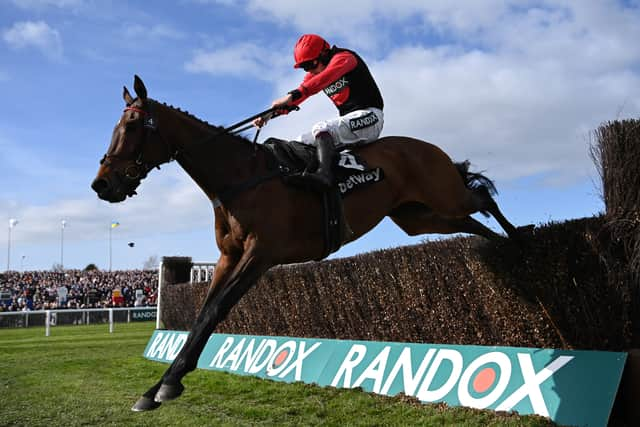How many fences in the Grand National? Order of jumps, course length and route
and live on Freeview channel 276
The Grand National has returned for yet another year.
There has been plenty of action at Aintree since the event began on Thursday (13 April). But the big race itself will take place on Saturday (15 April).
The longest jumping course in the world, the Grand National is one of the most famous horse racing setpieces. First taking place in February 1839, it is one of the most valuable races to win.
Advertisement
Hide AdAdvertisement
Hide AdIt is perhaps best known for its fences and jumps. Here is all you need to know:
How many fences in the Grand National?
Aintree is one of the most famous racecouses in the country. It features 16 total fences throughout the course, 14 of which are jumped twice - taking the total of jumps to 30.
The steeplechase is the longest jumping course in the world with the horses racing four miles (two amd a half furlongs).


What is the order of jumps and how high?
The horses will make a total of 30 jumps during the steeplechase on Saturday (15 April) evening. On its website, the Grand National reveals the order of the jumps and how high they are:
1 & 17 4ft 6in high, 2ft 9in wide
Advertisement
Hide AdAdvertisement
Hide AdThe first fence marks the start of the Grand National race and is in fact one of the smallest on the course. It is parallel to the Embankment, the large slope to the right of the course which houses 13,000 racegoers, all eager to see the horses begin their trip over the fences. This is a ‘settling’ fence and helps the runners and riders find their stride at the beginning of the race.
2 & 18 4ft 7in high, 3ft 6in wide
3 & 19 – Open Ditch
This is the first of three open ditch fences on the course, this being on the take-off side and measuring 7ft wide.
At 5ft high, it is also known as ‘Westhead’ after the late Steve Westhead who was one of Aintree’s fence builders and worked at Aintree Racecourse in the 1970s.
4 & 20 4ft 10in high, 3ft wide
5 & 21 5ft high, 3ft 6in wide
The landing side was levelled in 2013.
6 & 22 - Becher’s Brook 4ft 10” high, 7ft 6” wide
The most famous fence in the Grand National race is named after Captain Martin Becher who landed in the ditch after being unseated by Conrad in the first official Grand National race in 1839. This fence has been remodelled several times, with the drop on the landing side levelled in the 1990s and again after the 2011 Grand National race.
7 & 23 – Foinavon Fence 4ft 6in high, 3ft wide
Advertisement
Hide AdAdvertisement
Hide AdThis otherwise ordinary fence became extraordinary in 1967, when Foinavon was the only horse to successfully jump the fence after multiple horses shied and caused chaos on the course, going from last place to win the race.
8 & 24 – Canal Turn 5ft high, 7ft wide
This fence gets its name from the nearby Leeds-Liverpool canal and is noted for the sharp, 90-degree, left-hand turn that the runners have to take as soon as they have jumped the fence.
9 & 25 – Valentine’s Brook 5ft high, 7ft wide
With a 5ft 6in brook on the landing side, this fence was originally known as Second Brook, but was renamed after a horse called Valentine was said to have jumped it hind legs first in 1840.
10 & 26 5ft high, 3ft wide
11 & 27 – Open Ditch fence 5ft high, 10ft spread
This is the fence where red-hot favourite, Golden Miller fell after refusing to jump in the 1935 Grand National race. He won in record time in the previous year, 1934, and became the first horse to win the Cheltenham Gold Cup and Grand National race in the same season.
12 & 28 5ft high, with a 5ft 6in ditch on the landing side
Advertisement
Hide AdAdvertisement
Hide AdAlso known as ‘Booth’ after the late John Booth, which was the foreman of Aintree’s maintenance team in the 1970s.
13 & 29 4ft 7in high, 3ft wide
This fence had its landing side smoothed out prior to 2013.
14 & 30 4ft 6in high
A smaller, simpler fence which serves as an opportunity to settle the horses before they approach The Chair
15 – The Chair
The highest fence in the race at 5ft 2”, The Chair has a 5ft ditch before the fence and a raised landing side. Jumped only on the first circuit, it’s named after the chair the distance judge used to sit in to gauge the official distance between the winner and the runners behind. These horses were classed as ‘beaten by a distance’, with a ‘distance’ being more than forty lengths.
The original ‘chair’ is now located on a podium in the Red Rum Garden at Aintree Racecourse.
16 – Water Jump 2ft 6in high
Advertisement
Hide AdAdvertisement
Hide AdThe final fence on the first circuit is the lowest of the 16 fences. It has a wide stretch of water on the landing side and was first introduced in 1841, replacing a stone wall which was, at the time, 16ft wide!
How long is the course?
The steeplechase will be four miles long - or two and a half furlongs.
Comment Guidelines
National World encourages reader discussion on our stories. User feedback, insights and back-and-forth exchanges add a rich layer of context to reporting. Please review our Community Guidelines before commenting.